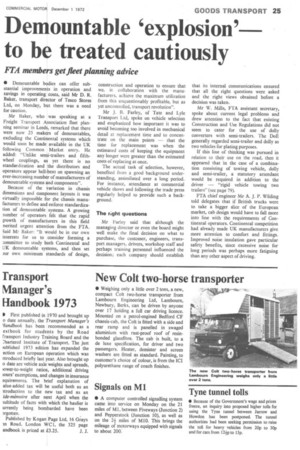Demountable 'explosion' to be treated cautiously
Page 27

If you've noticed an error in this article please click here to report it so we can fix it.
FTA members get fleet planning advice
• Demountable bodies can offer substantial improvements in operation and savings in operating costs, said Mr D. R. Baker, transport director of Tesco Stores Ltd, on Monday, but there was a need for caution.
Mr Baker, who was speaking at a Freight Transport Association fleet planning seminar in Leeds, remarked that there were now 25 makers of demountables, excluding the Continental systems which would soon be made available in the UK following Common Market entry. He added: "Unlike semi-trailers and fifthwheel couplings, as yet there is no standardization and the distributors and operators appear hell-bent on spawning an ever-increasing number of manufacturers of demountable systems and components".
Because of the variation in chassis dimensions and component layouts it was virtually impossible for the chassis manufacturers to define and enforce standardization of demountable systems. A growing lumber of operators felt that the rapid ;rowth of manufacturers in this field merited urgent attention from the FTA. ;aid Mr Baker: -It would be in our own interests for us to consider forming a zommittee to study both Continental and UK demountable systems, and then set )ur own minimum standards of design,
construction and operation to ensure that we, in collaboration with the manufacturers, achieve the maximum utilization from this unquestionably profitable, but as vet uncontrolled, transport revolution".
Mr J. 13. Farley, of Tate and Lyle Transport Ltd, spoke on vehicle selection and emphasized how important it was to avoid becoming too involved in mechanical detail at replacement time and to concentrate on the main points — that the time for replacement was when the estimated costs of keeping the equipment any longer were greater than the estimated costs of replacing at once.
The actual task of selection, however, benefited from a good background understanding, assimilated over a long period. For instance, attendance at commercial vehicle shows and following the trade press regularly helped to provide such a background.
The right questions
Mr Farley said that although the managing director or even the board might well make the final decision on what to purchase, the customer, engineers, transport managers, drivers, workshop staff and perhaps training personnel influenced the decision; each company should establish
that its internal communications ensured that all the right questions were asked and the right views obtained before a decision was taken.
Mr W. Mills, FTA assistant secretary, spoke about current legal problems and drew attention to the fact that existing Construction and Use Regulations did not seem to cater for the use of dolly converters with semi-trailers. The DoE generally regarded semi-trailer and dolly as two vehicles for plating purposes.
If this line of thinking was pursued in relation to their use on the road, then it appeared that in the case of a combination consisting of towing vehicle, dolly and semi-trailer, a statutory attendant would be required in addition to the driver — "rigid vehicle towing two trailers" (see page 79).
FTA chief engineer Mr A. J. P. Wilding told delegates that if British trucks were to take a bigger slice of the European market, cab design would have to fall more into line with the requirements of Continental operators. Continental competition had already made UK manufacturers give more attention to comfort and fittings. Improved noise insulation gave particular safety benefits, since excessive noise for long periods was perhaps more fatiguing than any other aspect of driving.
































































































































